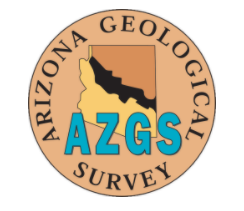Copper remains Arizona’s most abundant and valuable metallic mineral product.
In 2017, Arizona provided 68% of domestic copper production in the U.S.
Arizona has two major types of copper deposits: Porphyry Copper in southern and central Arizona; and, the Volcanogenic Massive Sulfide Copper of the United Verde Mine in Jerome of central Arizona. A third copper source includes copper of breccia pipes of the Breccia Pipe Province of northern Arizona.
Porphyry Copper Deposits
Most of the copper mined in Arizona comes from porphyry copper deposits. These are copper ore deposits associated with intrusive igneous rocks similar to granite. Porphyry describes the typical texture of these rocks, in which individual mineral grains about a tenth to a half inch in size are surrounded by smaller grains that are barely visible to the naked eye. These deposits, formed from saline, metal-bearing fluids expelled from cooling magma. Interaction of the fluid with heated groundwater yields a corrosive liquid that chemically alters rocks adjacent to the intrusion. Porphyry copper deposits commonly yield molybdenum and silver as co-products, were
The intrusive activity responsible for Arizona’s porphyry copper deposits occurred about 70 million years ago, in the Earth’s crust deep below the ground surface. The rich metal deposits were subsequently exposed millions of years later by faulting and erosion. Weathering processes, which accompany uplift and erosion, further concentrated the copper. This “secondary enrichment” occurred when pyrite (iron sulfide) oxidized, dissolved in rainwater, and formed an acidic iron sulfate solution that dissolved the main copper-ore mineral, chalcopyrite (copper-iron sulfide). The dissolved copper was redeposited, principally as the mineral chalcocite (copper sulfide). Bacteria may play an important role in both the dissolution and redeposition of the copper.
Volcanogenic Massive Sulfide Copper
A second major type of copper deposit in Arizona formed in Precambrian-age volcanic rocks such as those in the United Verde Mine at Jerome. Hot, metal-bearing liquids emerged from springs associated with ancient submarine volcanoes. When this liquid mixed with cold sea water, metallic minerals came out of solution as tiny particles that fell to the sea floor. If a metal-rich hot spring was active for a long time, a thick layer of metal-rich mud accumulated around the spring. These deposits contained copper, lead, zinc, silver, and gold. Modern “black smokers,” hot springs along sea-floor spreading centers, are small-scale analogs of these ancient deposits.
David Briggs Copper Histories
- History of the Verde Mining District, Jerome, Arizona
- History of the Ajo Mining District, Pima County, Arizona
- History of the Copper Mountain (Morenci) Mining District AZ
- History of Helvetia-Rosemont Mining District, Pima County, Arizona
- History of the San Manuel-Kalamazoo Mine, Pinal County, Arizona
- History of the Silver Bell Mining District, Pima County, Arizona
- History of the Warren (Bisbee) Mining District.
- Recovery of Copper by Solution Mining Techniques
- Superior, Arizona – An old mining camp with many lives




